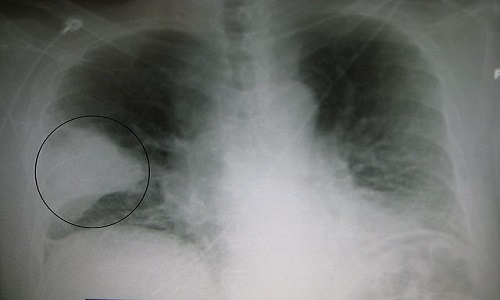Difference Between Pneumonia and Atypical Pneumonia
Pneumonia is an inflammatory condition within the lungs produced as a result of infection that primarily affects the alveoli. Generally it is caused by viral or bacterial infections and also by some autoimmune diseases that causes the inflammation. The common signs off pneumonia include fever, chills, productive cough and chest pain. Pneumonia is generally classified into two types – community acquired pneumonia and nosocomial (hospital acquired) pneumonia. In the former case the causative pathogens are primarily viruses and gram positive bacteria while in the later case the causative pathogens are primarily gram negative organisms. The most common bacteria involved are Streptococcus pneumoniae, Staphylococcus aureus, Escherichia coli, and Haemophilia influenzae. Sometimes in typical hospital acquired pneumonia there is involvement of Pseudomonas sp. too. If untreated the bacteria can gain access to the blood vessels and lead to a form of septicaemia (infection of the blood) called bacteraemia that can lead to end organ damage and finally death.
The general mechanism of development of pneumonia includes entry of viruses and bacteria from the throat and nasopharynx into the lungs where it attracts alveolar macrophages and neutrophils to initiate immune reactions that destroy the microorganisms. However during such reactions, cytokines (immune system signals) are activated which potentiates macrophages to infiltrate the infected regions and cause further inflammation. These inflammatory cells and the bacteria or virus forms the basis of pneumonia. The release of cytokines is responsible for the fevers, chills and fatigue associated with pneumonia. The quantification and extent of pneumonia is done through radiological examinations and blood tests. The C – reactive protein (cytokine) content in the blood is measured to estimate the severity of infection and probability of development of sepsis.
Pneumonia whether community acquired or hospital acquired is managed by antibiotics of the beta lactam class that includes penicillin and cephalosporin. As a rule of the thumb community acquired pneumonia are treated with first generation cephalosporin as involvement of gram positive organisms are suspected while in case of hospital acquired infections, third generation cephalosporin are used due to involvement of gram negative pathogens.
Atypical pneumonia is a type of pneumonia that is not caused by the traditional pathogens of “typical” pneumonia. The pathogens responsible for atypical pneumonia are Chlamydophila pneumoniae, Mycoplasma pneumonia, Legionella pneumophila, Moraxella catarrhalis, syncitial virus and influenza A virus. Hence the microorganisms involved could be bacteria, fungi, protozoa or viruses. The name was so coined because of its typical clinical features that distinguished it from typical lobar pneumonia. The key symptoms of atypical pneumonia are fever, headache, sweating and myalgia along with bronchopneumonia. Atypical pneumonia is treated with macrolide class of antibiotics like clarithromycin or erythromycin. Penicillin or cephalosporins are effective as because most of these atypical pathogens lack the cell wall where a Penicillin or cephalosporin exerts its antimicrobial actions.
A detailed comparison of pneumonia and atypical pneumonia is presented below:
| Clinical features | Pneumonia | Atypical Pneumonia |
| Type of Microorganisms involved | Primarily bacterial, may be viruses | could be bacteria, fungi, protozoa or viruses |
| Species of microorganisms involved | Streptococcus pneumoniae, Staphylococcus aureus, Escherichia coli, and Haemophilia influenzae | Chlamydophila pneumoniae, Mycoplasma pneumonia, Legionella pneumophila, Moraxella catarrhalis, syncitial virus and influenza A virus |
| Radiological Presentation | Lobar Pneumonia with lobar consolidation
Infiltration not seen in perihilar region and is localized centrally within the lobes and not towards periphery.
Any lobes can be affected |
Lobar consolidation absent as it involves restricted areas of lungs. Often reflects a primary infection before features of atypical pneumonia develop. This phase is also called occult pneumoniaInfiltration begins in the perihilar region and spreads to the periphery and not restricted to the lobes.Lower lobes are predominantly affected; however other lobes may be involved too. |
| Physical Signs | Fever may be present | fever, headache, sweating and myalgia are common |
| Haematological variables | WBC count increases | WBC count normal |
| Quantity and nature of Sputum | Bulk sputum with productive cough | Sputum is either mild or absent and produces non-productive cough |
| Treatment Regime | Infection treated with Penicillin or cephalosporin | Infection treated with clarithromycin or erythromycinNon responsive to sulphonamides or beta- lactams |
| Involves Upper respiratory tract infection | Not always | Frequently and associated with an irritating cough |
| Aspiration Involved | Can be caused by aspirating microbes fro intestinal tract | Never caused by aspiration |
| Environment that stimulates pneumonia | Non specific | Air conditioned environments where the Air-conditioning systems are not maintained. |
| Presence of extra pulmonary symptoms | No | Yes |
- Difference Between “Heart attack” and “Cardiac arrest” - June 24, 2016
- Difference Between Connective Tissue and Epithelial Tissue - June 22, 2016
- Difference Between Migraine And Stroke - January 11, 2016
Search DifferenceBetween.net :
 Email This Post
: If you like this article or our site. Please spread the word. Share it with your friends/family.
Email This Post
: If you like this article or our site. Please spread the word. Share it with your friends/family.
1 Comment
Leave a Response
References :
[0]Cunha BA (May 2006). “ The Atypical Pneumonias-Clinical diagnosis and importance”. Clin. Microbiol. Infect. 12 (Suppl 3): 12–24
[1]McLuckie, A., ed. (2009). Respiratory disease and its management. New York: Springer.p. 51
[2]https://en.wikipedia.org/wiki/Pneumonia



I went to Dr after being sick for 2 weeks, fever ,weaknesses, coughing . Dr said i have walking phnomia she put me on a very prowerful antibiotic levofloxacin 500MG. She said if not better in 2 days I need to go hospital!
Its been 2 days and im not better. Is there maybe something else that might be wrong?